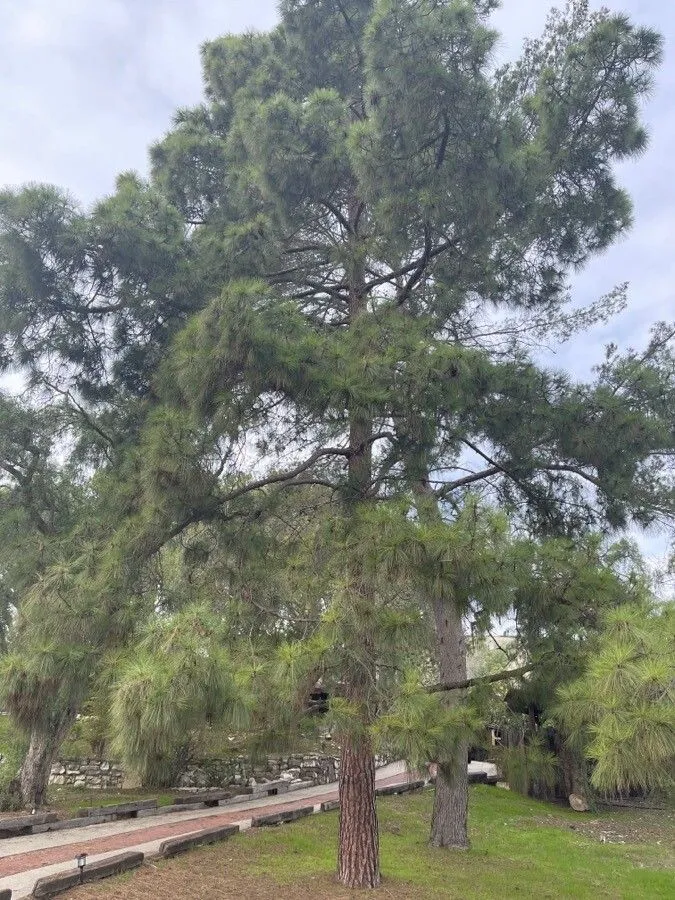
Author: L.
Bibliography: Sp. Pl.: 1000 (1753)
Year: 1753
Status: accepted
Rank: species
Genus: Pinus
Vegetable: Unknown
Observations: C. & SE. U.S.A.
The Loblolly pine, scientifically known as Pinus taeda, is a prominent member of the Pinaceae family. Recognized and formally described in 1753, this species has established itself as a cornerstone of the southern and central United States’ forests.
Loblolly pine is noteworthy for its adaptability and widespread presence, flourishing primarily in the southeastern regions of the U.S.A., where its towering stature is a common sight. This tree is characterized by its fast growth and resilience, making it a valuable asset for various ecological and economic purposes.
Ecologically, the Loblolly pine plays a crucial role in its native habitats. It provides essential shelter and food for a variety of wildlife species, contributing to the biodiversity and health of forest ecosystems. The tree’s needles, cones, and bark support numerous insects, birds, and mammals, establishing it as a keystone species within its environment.
From an economic perspective, the Loblolly pine is one of the most important sources of timber in the United States. Its wood is highly valued for construction, paper production, and other industrial uses due to its strength and workability. The rapid growth rate of Pinus taeda ensures a steady supply of this versatile material, supporting various industries and providing livelihoods for countless individuals.
The Loblolly pine’s resilience extends to its ability to thrive in different soil conditions, including poor, sandy soils where other plants may struggle. This adaptability makes it a preferred choice for reforestation and land rehabilitation projects. Its fast growth and ability to improve soil quality through organic matter contribution further enhance its role in environmental restoration efforts.
In conclusion, the Loblolly pine, or Pinus taeda, is far more than just a tree. It is a vital component of the southeastern U.S.A.’s natural landscape, a cornerstone of economic activity, and a symbol of ecological resilience. Its abundant presence, ecological importance, and economic value underscore why it is one of the most significant plant species within its range.
Deu: amerikanische terpentin-kiefer, weirauch-kiefer
Eng: frankincense pine, loblolly pine, oldfield pine, southern pine
Hun: keleti sárgafenyo
Afr: loblollyden
Swe: loblollytall
Fra: pin à encens
Spa: pino americano
Ita: pino da incenso
En: Loblolly pine, Southern Pine, Frankincense pine, Oldfield pine
Af: Loblollyden
Zh: Huo ju song, 火炬松
Cs: Borovice kadidlová
Eo: Torĉpino
Et: Tõrvikumänd
Fi: Loblollymänty
Fr: Pin à encens
De: Weihrauch-Kiefer, Amerikanische Terpentin-Kiefer, Weirauch-Kiefer
Hu: Keleti sárgafenyo
It: Pino da incenso
Ko: Teedasonamu
Lt: Terpentininė pušis
No: Virakfuru
Fa: کاج کندر
Ru: Сосна ладанная
Es: Pino americano
Sv: Loblollytall
© copyright of the Board of Trustees of the Royal Botanic Gardens, Kew.
Taken Jan 1, 1900 by EOL − Alicia Pimental from Queenstown, Maryland, United States (cc-by)
Taken Aug 6, 2006 by EOL − Rev. Xanatos Satanicos Bombasticos (ClintJCL) (cc-by-nc-sa)
Taken Jan 1, 1900 by EOL − rutlo on Flickr (cc-by)
Taken Mar 29, 2022 by Maarten Vanhove (cc-by-sa)
Taken Feb 24, 2022 by Allison Casarez (cc-by-sa)
Taken Mar 20, 2021 by Barbara Gordon (cc-by-sa)
Taken Mar 29, 2022 by Maarten Vanhove (cc-by-sa)
Taken Mar 7, 2021 by Chris Griggs (cc-by-sa)
Taken Dec 8, 2021 by ジョサエル 123 (cc-by-sa)
Taken Jan 16, 2022 by derek willard (cc-by-sa)
Taken Nov 4, 2018 by Raúl Fernández Recio (cc-by-sa)
Taken Mar 29, 2022 by Maarten Vanhove (cc-by-sa)
Taken Mar 7, 2021 by Chris Griggs (cc-by-sa)
Taken Jan 16, 2022 by derek willard (cc-by-sa)
Taken Jul 23, 2021 by don arbuckle (cc-by-sa)
Taken Mar 29, 2022 by Maarten Vanhove (cc-by-sa)
Taken Mar 7, 2021 by Chris Griggs (cc-by-sa)
Taken Jan 1, 1900 by EOL − Gerrit Davidse (cc-by-nc-sa)
Taken Jan 16, 2022 by derek willard (cc-by-sa)
Taken Jan 16, 2022 by derek willard (cc-by-sa)
Taken Jan 1, 1900 by EOL − Encyclopedia of Life (cc-by-sa)
Taken Jan 1, 1900 by EOL − Gerrit Davidse (cc-by-nc-sa)
Taken Mar 7, 2021 by Chris Griggs (cc-by-sa)
Taken Oct 27, 2019 by Matt Pinkerton ‘Gill Nursery Tx’ (cc-by-sa)
Taken Jan 24, 2021 by ilgrandediopan (cc-by-sa)
Taken Sep 14, 2002 by EOL − Steven J. Baskauf (cc-by-nc-sa)
Family: Myrtaceae Author: (F.Muell.) K.D.Hill & L.A.S.Johnson Bibliography: Telopea 6: 402 (1995) Year: 1995 Status:…
Family: Rubiaceae Author: Pierre ex A.Froehner Bibliography: Notizbl. Bot. Gart. Berlin-Dahlem 1: 237 (1897) Year:…
Family: Sapindaceae Author: Koidz. Bibliography: J. Coll. Sci. Imp. Univ. Tokyo 32(1): 38 (1911) Year:…
Family: Asteraceae Author: A.Gray Bibliography: Pacif. Railr. Rep.: 107 (1857) Year: 1857 Status: accepted Rank:…
Family: Fabaceae Author: Medik. Bibliography: Vorles. Churpfälz. Phys.-Ökon. Ges. 2: 398 (1787) Year: 1787 Status:…
Family: Aspleniaceae Author: (Cav.) Alston Bibliography: Bull. Misc. Inform. Kew 1932: 309 (1932) Year: 1932…